
| FRANCE TRIP- INTRODUCTION |
| Who are the Mannors and where did they come from? Several distant cousins have researched this question and shared their information on the Internet. From their research, it appears that the Mannor name was originally Menard, and that ten generations back, they emigrated from France to Canada. Specifically, a carpenter named Jacques Menard dit Lafontaine came to Three Rivers, Canada and married a woman named Catherine Forestier dit Fortier. Jacques was born in Mervent, France in 1629, and Catherine was born in La Rochelle, France in 1637. The word "dit" in French names means "also known as." |
 |
| --Click here to view my Mannor family paternal lineage-- |
| In January of 2007 I traveled to France on a business trip and visited the towns of Mervent and La Rochelle. |
 |
 |
| I was accompanied by my co-worker Darren Griffiths. We had a small rental car made by Citroen, which is a French automaker. |
 |
 |
| MERVENT |
| Mervent is a cute little village that sits on a hill with a lake wrapping around the bottom. The lake is formed by two rivers coming together, La Mere and La Vendee. Beyond the lake lies the Mervent national forest, which is 12,000 acres. The population of Mervent is 1,100 people. |
 |
| The winters are mild and rainy there, so it was about 60 degrees Fahrenheit. There were no leaves on the trees, but the grass was green and a few hardy flowers were still blooming. The lakeshore was dotted with little row boats, and I saw several people out fishing. |
 |
 |
| The town itself was very quiet on that Sunday morning. Occasionally an older person would come out of the bakery and head home carrying a long loaf of French bread. There was a trail system in the national forest, and small groups would come through town riding mountain bikes or 4 wheelers, covered with mud from head to toe. We saw several girls riding horses also. |
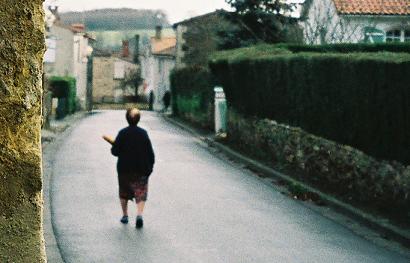 |
 |
| There were several restaurants in town. One was called La Rando and had a patio built out over the edge of the hill. We bought some souvenirs there. The proprietor was a nice lady who spoke only French. |
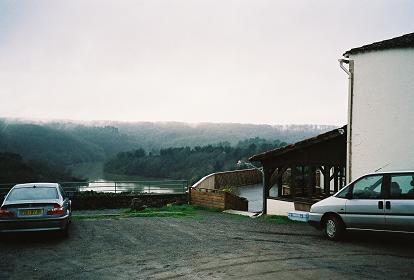 |
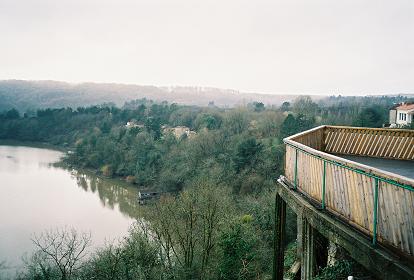 |
| Another restaurant, called Le Nautique, was at the bottom of the hill next to the lake. We had a very nice lunch there. The proprietor was a bustling man who informed us that he had originally been a bus driver in Dublin. It was nice to find someone who spoke English and could tell us a little about the town. He also provided us with a phone book, and I found one Menard named Stephane listed there. I plan to write him a letter and have it translated into French. |
| The village was pretty rustic with a vegetable garden and a chicken yard right in town. |
 |
 |
| There was one main intersection in town, in front of a very unique and attractive house. Some of the houses had large live grape vines attached to them. |
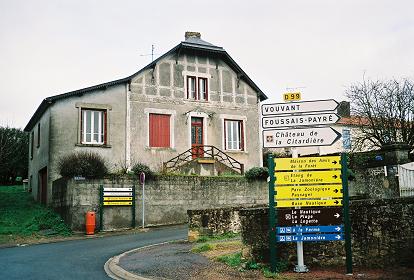 |
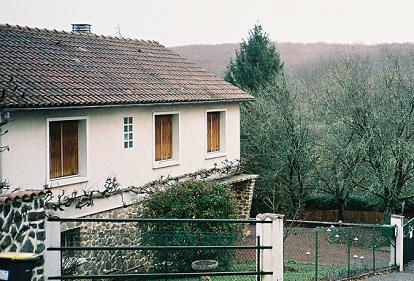 |
| There were several public buildings clustered around the town square, which also contained a war monument. We saw quite a few old fashioned wells around town with chains and buckets. |
 |
 |
| Next to the square was an old stone Catholic Church with a bell tower. The French word for church is eglise. The chimes on the tower rang out every 15 minutes. The church door was unlocked and we discovered a lovely interior with stained glass windows and Christmas decorations still up. |
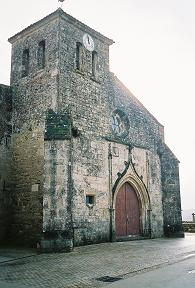 |
 |
 |
 |
| Further out was a large modern building with well-kept grounds. We initially thought this was a hotel, but later discovered that “Hotel de Ville” means town hall in French, so that explains why it wasn’t open on a Sunday. We also discovered an RV park with a surprising number of vehicles in it. |
 |
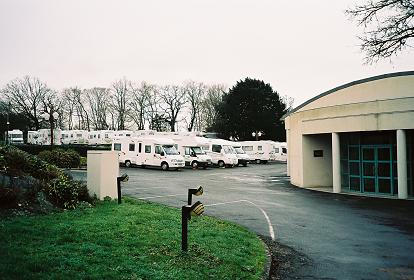 |
| France is divided up into 95 sections called departments, and Mervent is in the department called Vendee. Each department has its own coat of arms. We saw several signs with the Vendee coat of arms. |
 |
 |
| LA ROCHELLE |
| After leaving Mervent, we drove south-west for an hour to the city of La Rochelle. It is a large city on the Atlantic coast with a population of 76,000 people. |
 |
| We drove around town for a while, and then went down to the waterfront area called Port des Minimes. There was a nice beach there, but it was pretty empty in January. Out in the water was a round lighthouse called “Le Phare du bout du monde,” or “The lighthouse at the end of the world.” It was a replica of the lighthouse in Jules Verne’s book of the same name. |
 |
 |
| Next to the beach was a large marina. In fact we learned that it was the largest pleasure boat marina in Europe, with slips for 3,500 boats. |
 |
| There was a long walkway along the channel between the marina and the old harbor. Many people were out walking their dogs, riding their bikes, etc. Looking in toward the old harbor we saw the three towers that are the landmarks of La Rochelle. They were built in the 1400’s as part of the fortifications of the city. The Lantern Tower on the left was originally a light house. On the right, the Chain Tower and the St. Nicolas Tower guard the entrance to the old harbor. |
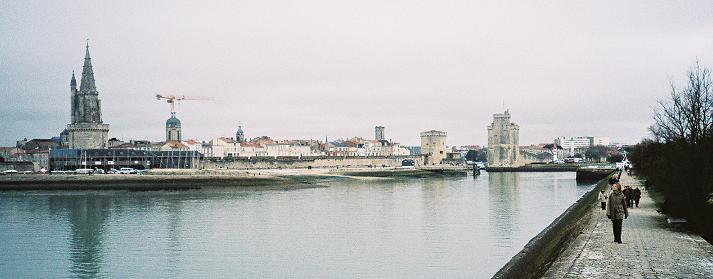 |
| Each large city in France has its own coat of arms. We saw several signs with the coat of arms for La Rochelle. |
 |
| Our day ended with a cup of coffee at a small restaurant. French coffee is similar to espresso in America, so it is better to order it mixed half and half with hot milk, which is called cafe au lait. |
| Back |